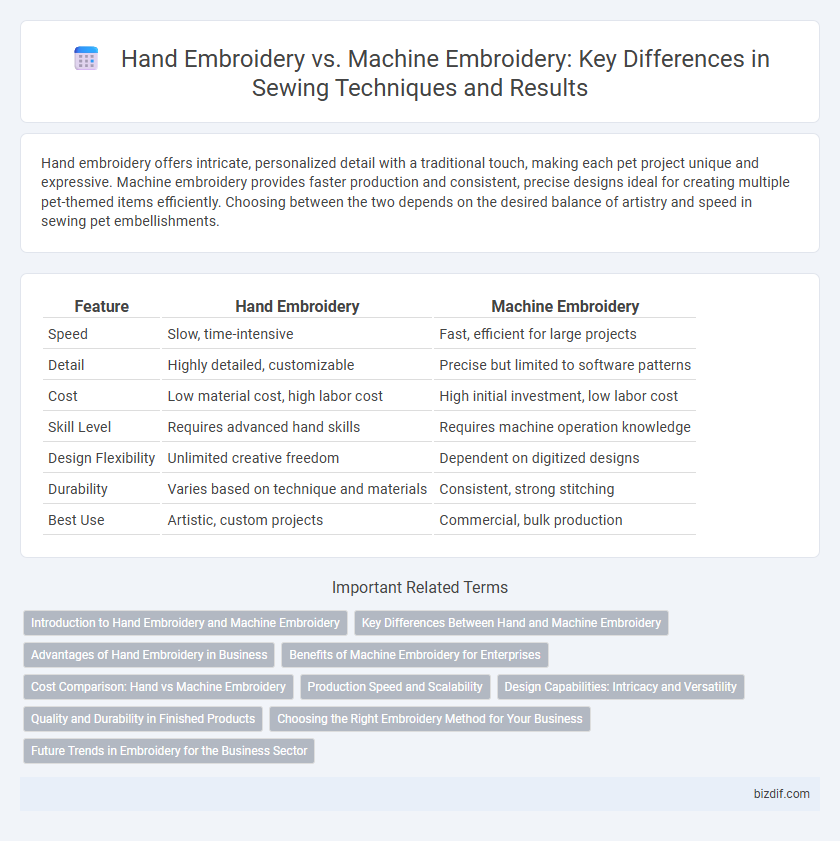Hand embroidery offers intricate, personalized detail with a traditional touch, making each pet project unique and expressive. Machine embroidery provides faster production and consistent, precise designs ideal for creating multiple pet-themed items efficiently. Choosing between the two depends on the desired balance of artistry and speed in sewing pet embellishments.
Table of Comparison
| Feature | Hand Embroidery | Machine Embroidery |
|---|---|---|
| Speed | Slow, time-intensive | Fast, efficient for large projects |
| Detail | Highly detailed, customizable | Precise but limited to software patterns |
| Cost | Low material cost, high labor cost | High initial investment, low labor cost |
| Skill Level | Requires advanced hand skills | Requires machine operation knowledge |
| Design Flexibility | Unlimited creative freedom | Dependent on digitized designs |
| Durability | Varies based on technique and materials | Consistent, strong stitching |
| Best Use | Artistic, custom projects | Commercial, bulk production |
Introduction to Hand Embroidery and Machine Embroidery
Hand embroidery involves creating decorative designs manually using a needle and thread, offering intricate detail and personalized craftsmanship ideal for unique textile art. Machine embroidery utilizes computerized sewing machines to produce precise and consistent patterns rapidly, making it suitable for mass production and uniform branding. Both techniques enhance fabric aesthetics but differ significantly in execution speed, customization, and complexity of design capabilities.
Key Differences Between Hand and Machine Embroidery
Hand embroidery features intricate, personalized stitches crafted manually, offering unique textures and artistic expression, while machine embroidery delivers consistent, precise patterns with faster production suitable for bulk projects. The skill level required for hand embroidery involves significant practice and creativity, whereas machine embroidery depends on digital design files and automated stitching technology. Thread tension and stitch variety in hand embroidery vary with the artisan's technique, contrasting with the uniform tension and repeatability controlled by computerized machines.
Advantages of Hand Embroidery in Business
Hand embroidery offers unmatched customization and intricate detail, attracting clients who value unique, artisanal craftsmanship. Small businesses benefit from lower startup costs and the ability to create limited-edition, high-margin products. This personalized approach enhances brand identity and customer loyalty in niche markets.
Benefits of Machine Embroidery for Enterprises
Machine embroidery offers enterprises enhanced production speed, enabling large-scale designs to be completed quickly and consistently. The precision of computerized stitching reduces human error, ensuring uniform quality across all products. Integration with design software allows for easy customization and scalability, making machine embroidery ideal for businesses seeking efficiency and versatility.
Cost Comparison: Hand vs Machine Embroidery
Hand embroidery typically incurs lower initial costs as it requires only basic supplies like needles and threads, whereas machine embroidery demands investing in expensive embroidery machines and specialized software. Over time, machine embroidery proves more cost-effective for large volumes due to faster production speeds and reduced labor expenses. However, hand embroidery remains economical for small projects or custom, artisanal designs where personalization justifies the higher time investment.
Production Speed and Scalability
Hand embroidery offers intricate, personalized detailing but is considerably slower, producing fewer pieces per hour compared to machine embroidery. Machine embroidery enhances production speed drastically, enabling the creation of large quantities with consistent quality, ideal for scalable business operations. Brands prioritizing fast turnaround and volume benefit significantly from automated stitching technology.
Design Capabilities: Intricacy and Versatility
Hand embroidery offers unparalleled intricacy with its ability to create delicate, detailed patterns through precise needlework and varied stitching techniques, making it ideal for unique, artisanal designs. Machine embroidery excels in versatility, enabling complex, consistent patterns to be reproduced quickly across different fabrics and scales, with computerized digitization supporting intricate layering and color transitions. Both methods provide distinct advantages depending on whether the focus is on bespoke craftsmanship or efficient mass production of elaborate designs.
Quality and Durability in Finished Products
Hand embroidery offers intricate, personalized details with superior thread tension control, resulting in unique textures and durability tailored to delicate fabrics. Machine embroidery ensures consistent stitch quality, high precision, and uniformity across large batches, enhancing product durability through reinforced stitch patterns and commercial-grade thread usage. Both methods deliver lasting finished products, but hand embroidery excels in artisanal quality, while machine embroidery prioritizes efficiency and standardized durability.
Choosing the Right Embroidery Method for Your Business
Hand embroidery offers intricate, customizable designs with a handcrafted aesthetic ideal for small-scale, luxury products, while machine embroidery provides speed and consistency essential for high-volume production and standard patterns. Choosing the right embroidery method depends on factors such as order volume, design complexity, budget, and brand positioning. Businesses targeting niche markets and premium pricing may lean toward hand embroidery, whereas those prioritizing efficiency and cost-effectiveness often select machine embroidery.
Future Trends in Embroidery for the Business Sector
Hand embroidery continues to hold value for artisanal and luxury markets due to its unique craftsmanship and customization potential. Machine embroidery is rapidly advancing with AI integration and automated digitization, increasing efficiency and scalability for large-scale production. Future trends emphasize hybrid approaches that combine handwork's artistic detail with machine precision to meet diverse business demands and sustainability goals.
Hand embroidery vs Machine embroidery Infographic

 bizdif.com
bizdif.com